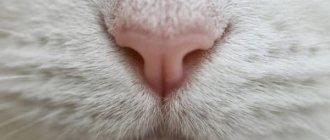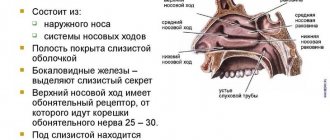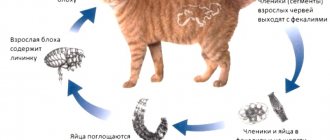Raising a pet, especially a cat, is not as easy as most people think. If treated poorly, your loved one can suffer seriously from indigestion and even cancer. One of the most common phenomena is bleeding during bowel movements.
Blood spots in kittens' stool can come as a shock, but there are a few things you can do to improve the situation. A good understanding of the possible causes and effective medical care, including first aid, will likely be helpful.
Reasons for appearance
There are several of them, and blood in the stool can be caused by various diseases and conditions, among the main ones are:
- Parasites. Helminths adhere to the intestinal walls, damaging them, which causes the appearance of bloody discharge with feces. The stool takes on a brown tint.
- Hard feces (constipation) when passing through the intestines can lead to injury.
- Foreign body, for example, a piece of plastic, tubular bone, etc. During a peristaltic wave passing through the intestines, it begins to move, injuring the surrounding tissues, as a result of which blood appears in the animal’s feces.
- Poisoning, for example, with rat poison. If your pet catches rats, mice, or the house has recently been treated for them, the animal may accidentally eat some of it. Once absorbed, the toxic substance leads to poisoning of the body, which is accompanied by bleeding in the gastrointestinal tract and the pet defecates with blood.
- Malignant and benign tumors, as well as the growth of their metastases with germination into the digestive organs.
- Inflammation of the perianal glands (located in the anus area of cats and used to mark territory). With this disease, they increase due to edema, which can develop into a fistula. During the act of defecation, trauma to the inflamed gland occurs and drops of blood appear.
- Coronavirus infection. This virus leads to the development of gastroenteritis, enteritis and peritonitis. As a result of the development of these diseases, damage to the intestinal mucosa occurs and, as a result, diarrhea with blood, vomiting and other signs of the disease. Young animals under 3 years of age and older animals over 10 years of age are most susceptible to infection. Coronavirus infection is a common cause of death for pets; 90% of those infected die. This is a serious condition that requires immediate veterinary attention.
- Problems with the blood clotting system, which leads to intestinal bleeding. In this case, not only feces interspersed with blood appears, but also vomiting with it. This condition can be dangerous for the animal and requires urgent veterinary attention.
- Colitis. Older animals are most susceptible to this problem. The stool changes not only its color, but also its smell. Along with the feces, dark-colored blood and mucus are released, and constipation alternates with diarrhea.
- Poor absorption of dry food. This is often due to the fact that the animal drinks little water after eating such food, which leads to severe compaction of feces, which injure the delicate intestinal mucosa.
- Various diseases of the gastrointestinal tract. Among the main ones are: gastritis, pancreatitis, cholecystitis, peptic ulcer of the duodenum and stomach and many others. With these diseases, the blood in the feces will be dark, even black, in color.
- Long-term constipation leads to the formation of cracks in the anus, and blood is released in scarlet color at the end of the act of defecation.
- Polyps in the colon lead to trauma and bleeding.
- Allergy to stabilizers, dyes and corn flour contained in dry food. The main recommendation for this condition is a partial or complete transition to separately prepared natural food.
- Infection with bacteria, such as salmonella, colibacteria and intestinal tuberculosis. In this case, inflammation of the intestinal mucosa occurs, the permeability of the vessels located in it increases and, as a result, the detection of blood in the cat’s stool.
- Rectal prolapse caused by prolonged labor, constipation or diarrhea due to strong straining of the pet.
This is not the entire list of diseases and conditions that can provoke the appearance of blood in the stool, and the symptoms are similar. Therefore, you should not make a diagnosis and prescribe treatment on your own; it is better to trust a professional – a veterinarian.
What can cause blood to appear in an animal's stool?
First of all, it is worth paying attention to the fact that prolonged loose stool in an adult cat or kitten itself requires consultation with a specialist, especially if it is diluted with mucus or blood. Often, such symptoms act as harbingers of illness, signaling the occurrence of serious pathological processes in the pet’s body. Under no circumstances should you postpone a visit to the doctor. He will not only help you find out the causes of your cat’s health problems, but will also prescribe appropriate treatment. If you do nothing, the consequences for your pet can be very dire.
The determining factors due to which a cat goes “out of need” with blood for some time are mainly the following:
- the presence of a bacterial infection in the cat’s gastrointestinal tract, the presence of helminthic infestations;
- severe allergy or reaction to an intolerant product;
- benign tumor formations (cysts, polyps);
- cancer of the lower intestine;
- accidental ingestion of poison used to kill rodents;
- damage to the anus;
- problems and disorders of blood clotting;
- intestinal obstruction, constipation.
Symptoms
The appearance of blood in the stool is always an alarming signal for the owner that the animal requires specialist help.
You should be especially vigilant and see a veterinarian as soon as possible if your pet has the following symptoms, in addition to blood in the stool:
- during the act of defecation, the animal meows heavily - this indicates that it is painful for him to defecate;
- the appearance of vomiting;
- reducing the amount of food consumed until completely giving it up;
- the pet becomes weak, apathetic, stops playing;
- the cat is very worried, meows often - may be associated with pain in the abdominal area;
- rise in body temperature;
- frequent urination;
- the pet begins to drink often and a lot;
- sudden weight loss;
- blood and its clots around the anus.
When pain occurs as a result of any diseases and conditions accompanied by blood in the stool, the animal experiences a severe stress situation, which further aggravates the situation. Therefore, timely treatment is simply necessary for your pet.
Worms are a common problem in pets.
Signs of their presence in a pet’s body, as a rule, are not limited only to the presence of blood in cat feces. If a cat’s activity has decreased, it behaves sluggishly, there is practically no appetite, stool with blood is mostly liquid and sometimes vomiting occurs - in almost 9 such cases out of 10, when examining the animal, parasites are found. However, you don't need to do anything yourself.
Only a qualified doctor should diagnose the presence of worms and prescribe the necessary medications for treatment. Only he will be able to prescribe the correct dosage and regimen of medication.
We recommend reading: Symptoms and treatment of worms in cats
Steps to take before visiting a veterinarian
If blood is found in your pet’s stool, but there are no signs of a serious condition described above, you should observe your pet for a while and find out some points:
- frequency of blood appearance: once or regularly;
- approximate quantity: in the form of drops, veins, clots or completely;
- Has anything changed in the pet’s behavior: has it become restless, sleeps a lot, stopped playing, etc.;
- is there anything in the feces other than blood: hair clots, mucus, undigested food particles, etc.;
- has eating behavior changed, how much water is consumed;
- the presence or absence of vomiting, diarrhea or constipation;
- measure the temperature and check whether it is within normal limits.
All these parameters are very important for making a correct diagnosis and the veterinarian will definitely ask about them.
Diagnosis of the causes of bleeding in cats
In order to make a correct diagnosis, the veterinarian will interview the owner to find out important points in the pet’s life and examine the patient. After this, they move on to diagnostic studies.
For this purpose, the following is carried out:
- general and clinical blood and urine tests;
- coprogram - helps to clarify the presence of undigested food, the presence of blood and other parameters;
- examination of stool for the presence of worms and protozoa;
- Ultrasound of the abdominal organs and kidneys;
- X-ray examination;
- If necessary, a colonoscopy will be performed. This study makes it possible to examine the animal's intestines from the inside.
Risk group – neutered cats
You can talk about the benefits or harms of castration around the clock. And about ethical issues too. But the fact remains that this process inevitably affects the predisposition to hematuria and diseases of the urinary system of cats. Cats have their uterus and ovaries removed, which also leads to the same consequences. Especially if they are fed monotonous food.
Ginger cat
As a rule, after this the animals become lazy and move little. Metabolism and urine concentration change. They will not be able to avoid risk.
After this procedure, particles appear in the pet’s secretions, which collect into mixed lumps. They cause injury to the urinary system. This leads to a bad result.
Possible treatment
Depending on the reasons that caused the appearance of blood in the stool and the diagnosis, the principles of treatment will differ:
- If this condition is caused by dry food, you should completely abandon it. Dry and canned cat food is the same as fast food for us. Since it contains a large number of dyes, preservatives, thickeners and all kinds of additives that have a bad effect on the pet’s body. But do not forget that feeding from a human table is even more dangerous for your pet. It is necessary to start preparing natural food for him separately. You should consult your veterinarian about products approved for use. The veterinary clinic will help you develop an approximate menu, as the nutrition must be balanced. But there are rules: you cannot give fatty, spicy, salty and sweet foods. You can feed boiled chicken, rice, boiled vegetables. Smecta dissolved in a small amount of water helps to normalize stool. Probiotics will help normalize intestinal microflora. For this purpose, Hilak Forte is prescribed; it is a solution for oral drip use, which makes it convenient for use at home in the dosage specified by the veterinarian.
Read about what cats and cats are not allowed to eat.
- The cause is infection with bacteria or helminths. Antibiotics and antiparasitic agents are prescribed, as well as intravenous infusions of vitamins, microelements and saline. They will help maintain the acid-base balance of the body, reduce intoxication and improve the overall well-being of the cat.
- When problems with the liver and gall bladder are detected, hepatoprotectors are prescribed, for example, Essentiale Forte. It is administered intravenously or subcutaneously, in some cases oral (inside) use is acceptable. You should strictly adhere to the prescribed dose.
- If there are problems with the blood coagulation system, hemostatic drugs and vitamin K are prescribed.
- The cause of bleeding is the excessive accumulation of hair and the formation of lumps from it in the intestines - special medicinal foods are prescribed to help eliminate it naturally.
- If there are problems with the pancreas (pancreatitis), taking enzymes is indicated.
- If tumors, foreign bodies or polyps are detected in the intestines, surgical treatment is mandatory, eliminating the problem radically. Drug therapy in such cases is powerless.
- If an animal is poisoned, wash away its remains from the body by gastric lavage and enema. Intravenous administration of a diuretic and solutions is also prescribed to maintain the acid-base balance of the blood, which promotes a speedy recovery of the pet and improves its overall well-being.
It is worth remembering that the sooner qualified assistance is provided, the greater the chances of recovery.
Prevention
To prevent constipation and other conditions that can cause blood in the stool, you should follow several simple preventive measures:
- Proper nutrition for your pet is the key to a long and healthy life. It is worth giving up canned and dry food and switching to a balanced diet of natural food. At the same time, be sure to dose the food and not let your pet consume it excessively.
- Regular deworming therapy.
- Avoid contact with street animals.
- Make sure your cat always has clean drinking water.
- Give multivitamin complexes prescribed by your veterinarian.
- For diseases of the pancreas and liver - a course of hepatoprotectors and enzymes several times a year as prescribed by a veterinarian.
- When treating your home for rodents, isolate the animal to prevent it from eating the poison.
- Bring him to the veterinary clinic regularly for examination.
- If problems with intestinal microflora are identified, it is mandatory to take probiotics.
1111
How to collect urine for analysis?
You should remove the filler from the tray and wash it thoroughly. After the animal passes the baby, its biological fluid should be collected with a disposable syringe or pipette and poured into a specialized sterile container (sold in veterinary pharmacies). If your cat refuses to go into the litter box without litter, you can fill it with a non-absorbent substrate.
Remember: the optimal volume of urine for analysis is 20 ml. It should be collected no later than 2 – 4 hours before going to the veterinary clinic to obtain an accurate result.











